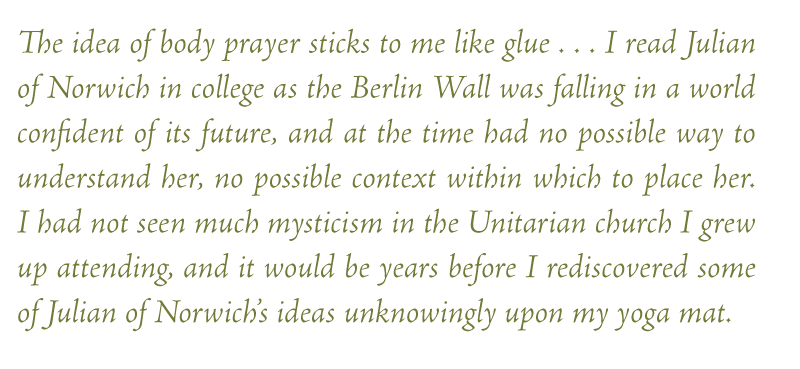by Mary Petiet
This article is featured in the Autumn 2015 issue of The Wayfarer (Vol 4 Issue 2)
Visit our bookstore to purchase an e-edition or print edition. Go to the Store»
All shall be well, and all shall be well and all manner of thing shall be well.
—Julian of Norwich
I am laying in shavasana, corpse pose, the final assimilating pose of any Hatha yoga practice. I am sprawled on my back on my yoga mat and my right hand receives a pleasant weight that I can wrap my arm around. I hold this weight and I know suddenly in that inner way of knowing that I am holding my own soul.
I come back from shavasana slowly and look at my friend on the mat beside me. She is near tears. She says, “I held my father in my right hand.” We regard each other across our mats, slowly, slowly, coming back to ourselves.
I have practiced yoga for eight years with the same teacher. In that time we have left the YMCA, where we used to practice, for the far more intimate church hall where we now meet. The core of our group consists of about eight women, and we gather twice weekly. My teacher is not a guru, she does not foster dependence. Rather she leads, and she gives us the tools to possibly lead ourselves.
Our classes become so intense I ask my teacher what, exactly, we are doing. “Body prayer,” she replies. Her name is Sherianna Boyle, and she is quick to credit the church priest for the phrase. “Libby Gibson called it body prayer when I asked her if we could practice yoga in the church, and that set the tone,” she explained. Libby is a bit of a local celebrity, she has infused her Episcopalian church, St. Mary’s, with terrific energy and a full congregation. She also practices yoga and encourages us to practice in her church hall, where the sacredness of consecrated space enhances the experience.
The idea of body prayer sticks to me like glue. I understand it, it is familiar, but I cannot place it. Until a friend tells me in a moment of doubt, “All shall be well,” and suddenly I grasp it. It’s Julian of Norwich, the fourteenth century English mystic and pioneer of body prayer. I read Julian of Norwich in college as the Berlin Wall was falling in a world confident of its future, and at the time had no possible way to understand her, no possible context within which to place her. I had not seen much mysticism in the Unitarian church I grew up attending, and it would be years before I rediscovered some of Julian of Norwich’s ideas unknowingly upon my yoga mat.
While yoga is an ancient practice, it was conspicuously absent from the fourteenth century town of Norwich in England, so a woman there invented her own practice. Today we do not even know her name, we call her Julian of Norwich (1342-1416), in reference to her church, the Church of St Julian, and her town, Norwich. She was an anchorite, and as a mystic she was open to receiving the greater energy that informs the universe. Her practice is called body prayer, and it is very much like Sherianna’s yoga. It is prayer through motion with the intention of connecting the practitioner to the divine energy source within. As we, today, use the movement of yoga to yoke to the divine, Julian of Norwich moved through prayer to what she called a ‘oneing’ with the divine source, which she knew as God, and surprisingly for her time, her God had a distinctly feminine aspect.

Julian devised four stages of prayer through movement: await, allow, accept, and attend. The first stage, await, is a posture of receiving. She held cupped hands extended at her waist to receive the presence of God. The second posture, allow, is a stance of opening to what god has to say, allowing a sense of God’s presence to come. She reached up with her hands open. The third posture, accept, she assumed with her hands cupped at her heart, in acceptance of whatever gift comes or does not come, followed by the final posture, attend, assumed with hands extended and palms open. This is the willingness to act on the gift given. Her movements allow the mind to relax, and through them achieve the same meditative state induced by the movements of yoga.
A strong component of female mysticism is that it happens within the body. Julian of Norwich’s body prayer flips the patriarchal tradition that Christian enlightenment occurs as a transcendence of the body, in which the body becomes an unimportant impediment. Instead of renouncing her body to access the divine, Julian goes through her body as she follows the motions of her prayer, finding her oneness with the god within through movement.
Libby Gibson at St. Mary’s says body prayer pulls her out of her mind, which is one of the great challenges of our time and culture. “We are driven into our heads through dualism and entrenched position, and our defense of these mental positions causes violence. The return through the body quiets the mind and its chatter,” she said. She sees body prayer as part of a current opening of cultures, exposing Christian dualism to the mind and body, returning our understanding of the gift of being incarnate in a human body, and countering the sublimation of the feminine. While body prayer can be found in simple tasks that create, such as knitting, gardening or cooking, Libby said, “Childbirth is the ultimate body prayer.”
Julian knew harrowing times of uncertainty and found within them a quiet place of connection to divine love. She saw Bubonic plague ravage Europe, killing half the population of Norwich, and historians speculate that she lost her own husband and children to the contagion. She saw political upheaval as England endured the Hundred Years war and was rocked by a series of peasant revolts, the largest led by Wat Tyler in 1381, as the people tried to wrest a more equal distribution of power and resources from the nobility. In 1378 she saw the church begin the Great Schism, a 68 year split between two pontificates, adding further disruption to an already hectic situation. She suffered an unnamed sickness so severe at age 30 that last rites were read, yet she revived, entered religious orders, and began to write of the profound visions she received during her illness. She is the first known English woman to have written a book.
In her visions, Julian saw a tiny thing the size of a hazelnut in the palm of her hand. She wrote in the fifth chapter of her Revelations of Divine Love, “I looked at this with the eye of my soul and thought, ‘what is this?’ And this is the answer that came to me, It is all that is made. I saw that this tiny thing had three properties that were essential to it. The first is that God made it; the second is that God loves it; the third that God preserves it. I was astonished that it managed to survive: it was so small I thought that it might disintegrate. And in my mind I heard this answer: ‘It lives on and will live on forever because God loves it.’ So everything owes its existence to the love of God.”
In a century ridden with calamity that had produced a very dark image indeed of God as punisher, Julian of Norwich found a compassionate deity who embraced all with love, and she believed in the salvation of all through this immense love. In the ninth chapter of her Revelations she says, “For everything is included in the portion of humanity who are going to be saved. For God is in man and God is in everything.” Five hundred years later Ralph Waldo Emerson would write in Nature, “I become a transparent eyeball; I am nothing; I see all; the currents of the Universal Being circulate through me; I am part or parcel of God.”
Julian’s vision of God includes the feminine aspect, as she considered God both father and mother. In Chapters 59-61 of her Revelations, Julian states that “Jesus Christ …is our true mother; we derive our being from him-and this is the foundation of motherhood… For just as truly as God is our father, so too God is our mother.” Julian further equated the bond of mother and child with the bond the faithful can have with Jesus, stating in the same chapters, “A mother holds her child tenderly to her breast, but our tender mother Jesus takes us right inside his blessed breast.
Julian was ahead her time and not quite doctrinal, but her views were overlooked, probably because she was a woman, and probably because she at least framed her views within the context of the church. She was fortunate. The fourteenth century was especially unkind to women, who were either put upon the pedestal of purity with the Virgin or thrown into the mud with the Whore of Babylon. The plague required a scapegoat, and all too often a woman accused of heresy would serve.
Today we gather twice weekly in the church hall to preform our own body prayer yoga in our own time of uncertainty. Mankind’s future is dubious. Scientists have announced that we are in the midst of the 6th extinction, and that we are its cause. If it continues unchecked, how many more generations can the earth maintain? All things are connected, and the larger extinction is ultimately our extinction. We live daily with the specters of Ebola, climate change, terrorism and unchecked firearms, and in an echo of Wat Tyler’s peasant revolt, we live in a time of widening income discrepancy as the 1% hold onto our country’s resources and we slip closer to oligarchy. Like Julian, we find our way deep within to an aspect of the divine feminine that brings peace in the confusion.
We also live with private losses. Each member of our yoga group has lost greatly, as we think Julian did, and the raising and the moving of energy that yoga facilitates as body prayer accesses the same oasis Julian found, acting as a powerful healing agent. Julian’s calm is still there for us, bringing peace and understanding, while inspiring creativity. We find the sacred space within, and from there access the universe. A woman’s body is made to create and nourish life in a timeless communion, which anchors her simultaneously to both the sacred and the profane worlds. Julian straddles the two realities by working through bodily movement, just as we do upon on our yoga mats, and as Julian finds unity in the love of God, yoga joins us with the energy of the divine, the light flowing through our manifestations in constant creation.
Sherianna Boyle’s teaching and motto is “choosing love” and her practice has led her to writing a book of the same name. My friend across the yoga mat paints the mandalas she sees as she practices, and my own book was also inspired by this energy, these glimpses of wisdom brought through the quiet of the pose, the quiet inner refuge that opens the universe.
Sherianna explains that we are raising our energy vibration so that we may be open to the greater vibration. We are seeking spirituality within a mostly Christian context because that is the tradition we know, yet we are very secular in our approach, and as we borrow from other traditions, such as yoga, and practice in the church’s sacred space, always with the same core group, always with the same intention, I imagine what we do and experience has been done and experienced before by Julian of Norwich.
What we find is the same quiet place that Julian found. The same healing connection and the same love. What she perceived as the hazelnut of the world, made and held and loved by God is what we perceive on our own terms as we connect to the same energy via our own body prayer. We find the same calm, the same foundation within as we raise our own energy as a group to meet the spiritual energy of the divine source. And the energy meets each of us where we need it, showing us what we need to see and telling us what we need to know. It offers strength and balance and healing, we connect and we soar, we return and we share.
_______________________________________
Armstrong, Karen, Visions Of God (1994) Bantam Books
Jewett, Ethan Alexander, The Body Prayer of Julian of Norwich, (2012) https://www.youtube.com/watch?v=7iImZilFvOE
Photos 46, 48 and 49 © 2015 Katherine Kaess Christensen

